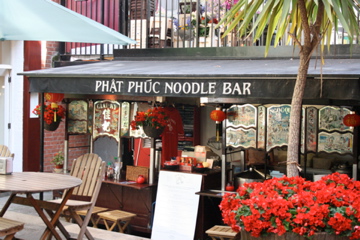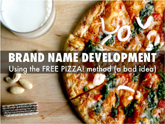News
Is Strange A Good Naming Strategy?
In 1967 The Doors wrote a song called “People Are Strange.” In the chorus, the lyrics include the phrase, “No one remembers your name when you’re strange.” It seems like some current fashion labels think that advice no longer applies.
"If you are building a brand from scratch, you're going to get more reaction from something unexpected and strange," says Tom Julian in a New York Times piece by David Colman (2/7/13). It seems as if fewer fashion designers are naming their lines after themselves and are launching lines of clothing with strange names. Consider what Shane Gabier and Chris Peters call their new line: Creatures of the Wind. It's taken from a 1957 Johnny Mathis song. "We liked the moody atmosphere and the way that the song brings up different associations," says Shane.
David Colman’s article is titled “No One Forgets a Name When It’s Strange.” Apparently Mr. Colman is not a child of the 1960s. One of the first rules of naming is figure out a way to make it memorable. Strange does not equal memorable.
Consider Natsuko Kanno's line which is called 4 Corners of a Circle. Apparently it is memorable for being hard to remember. Publicist Erica Roseman says nearly everyone — even those who work on the line — mess it up. "It was '4 Circles in a Square,' '4 Corners of a City.' No one ever got it right."
Jean Godfrey June, the beauty and fashion news director at Lucky, thinks the quirky names can be a mixed blessing. "It goes one way or the other, they charm or they repel … The offbeat name is a way to distinguish yourself and sound mysterious and underground-y. The trade-off is, purposely making yourself sound obscure can turn into a self-fulfilling prophecy."
You’ve got that right, Jean!
The lesson here is that strange is not necessarily a good or a bad thing, but what is important is how the name relates to the target customer and the product itself. Strange for the sake of strange can be bad, but if the name makes the target customer curious about a product and willing to investigate it further, then strange can be good. This was validated in a study in The Journal of Consumer Research in 2005 where the investigators looked at differences in names for crayons. The findings indicate that consumers preferred “slightly ambiguous” names such as “Blue Haze” or “Alpine Snow” to plain descriptive names such as “Blue” or “White.” But their findings also indicated that names without some reference (e.g., calling a blue crayon “Fred”) were totally confusing to consumers.
Net, net, don’t assume that strange is necessarily good or bad. Like most things in life, the nuances are what make the difference between a great name and a confusing name.
The Worst Restaurant Name of 2012
As a professional name developer, I am constantly struck by the “creativity” of small business owners. Sometimes the owners think they are being cute or clever. Sometimes they are just being stupid. Here are just a few examples of bad restaurant names I discovered in 2012. Which do you think is the “Worst Restaurant Name of 2012?”
B.A.D. Sushi (http://badsushi.net) – Apparently the owners think their acronym for “Best And Delicious” sushi is clever. While bad sushi is certainly memorable, I don’t see it generating a lot of positive vibe.
Crapitto’s (http://www.crapittos.com) – OK, I know this is a family name. But no matter how proud you are, I don’t think anyone wants to go to Crapitto’s for that special dinner.
Lick-A-Chick (http://www.atyp.com/aklickachick) – OK, I dig the alliteration, but I’m pretty sure the owner is trying too hard to be clever.

Phat Phuc (http://www.phatphucnoodlebar.com) – The name may translate as “Happy Buddha” in Vietnamese, but Americans might mistake this name of a London restaurant as meaning something derogatory.

Fu King Chinese (http://www.facebook.com/pages/Fu-King-Chinese-Restaurant/123368567719721) – Yup. No mistaking what they sell here, eh?
Which name deserves the “Best Worst Name of 2012” award?
Weather Channel To Name Winter Storms
Well, why not? Why should hurricanes have all the fun? For reference, details are provided in the link below, but really how many details do you need? Ideas like this don’t require a lot of explanation!
The Weather Channel says naming the storms will result in clearer communication about the systems. Seriously? Telling me that “Brutus” (one of the actual names they plan to use) is dumping 3 feet of snow on Buffalo is clearer than just saying Buffalo is getting 3 feet of snow? What’s Brutus got to do with it? Some of the other names they plan to use are Athena, Caesar, Rocky and Zeus.
Obviously someone at The Weather Channel thinks they can drive interest/viewership by naming winter storms. Yes, it is no longer sufficient to have poor Jim Cantore standing in the sleet while a bus rolls by and swamps him with slush. We now need to know that “Brutus” did that to poor Jim. I am sure that will make him feel better.
I understand the fact that identifying things is basic human nature. Everything needs an identifying name. But giving a “human” name to a blizzard is going too far. Where do you draw the line on this one?
Will we start naming high pressure systems? They hang around generally produce lovely weather for a number of days. Personally, I think Athena (goddess of wisdom, courage, and inspiration) makes a better name for a high pressure system than for a winter storm!
Drug Names Gone Wild
I just saw that a new incontinence drug has been approved. The FDA approved Myrbetriq for Overactive Bladder.
As a consumer, I must say…”HUH?” What is a Myrbetriq? How do I pronounce it? What is it for?
Have pharmaceutical companies gone insane? I’ve named Rx drugs before and I can tell you that the landscape is not a simple one due to numerous FDA regulations about implying benefits in the name and numerous potential trademark issues.
But I have never resorted to choosing random letters out of a hat…which is the only explanation I can come up with for why Astellas Pharma US, Inc. chose this name.
Seriously!?! Hey Astellas Pharma…please keep me in mind for your next Rx drug. I am certain I can do better (can’t do much worse!).
The Perils of Naming Contests
Naming contests. Sounds like a good idea, right? A company needs a new name and it decides to engage its employees to come up with a new name. What could go wrong? Continue reading
What The Heck Is Going On?
I’m beginning to think the world is losing it. This month we have witnessed incredible stupidity in name development. As a professional name developer, I am appalled.
Let’s play a game. This is the name of a new company: Mondelez International. What does Mondelez International make? Give up? Continue reading
What’s in a name? That which we call an iPad by any other name would sell as well.
"What's in a name? That which we call a rose by any other name would smell as sweet." William Shakespeare
With apologies to William Shakespeare, the title of this post reflects the fact that you could call “The New iPad” pretty much anything and it would be a gangbuster seller.
But why not have a proper naming architecture? Because this is Apple, and doing the predictable is not what they do. At least that is what Phil Schiller, Apple’s Senior VP of Marketing, said Continue reading
The Dangers of Name Fusion
I illustrated several “Naming Faux Pas” in a blog post a while ago (https://nameflash.com/2010/06/naming-faux-pas/) but I just found an example of a common naming practice taken to the extreme.
The naming practice is that of “word fusion” where you develop a name by bonding two or more words together and you overlap similar portions. For example, you create a new name BRUSHOG by overlapping the letter “h” in combining the words BRUSH and HOG. It is a commonly used naming practice, but sometimes it goes very wrong. Here is a perfect example of when it should not be done: Continue reading
Mascots Are Brands Too
In a recent newspaper article (ow.ly/901Cl) the local sports editor presented some unusual team mascots that exist in our area and across the country. For example, in the Greater Pittsburgh area we have Big Macs (Canon-McMillan), Talbots (Hampton), Planets (Mars Area), Maples (Mapletown), Mighty Mikes (Carmichaels) and Hillers (Trinity). The Big Macs of Canon-McMillan were not named after the iconic McDonald’s sandwich, despite the fact that the McDonald’s Big Mac was invented in Western Pennsylvania (http://www.msnbc.msn.com/id/20423294/ns/business-retail/t/big-mac-gets-its-own-museum/#.TzaBLLR7SSo).
But some schools have crazier names, including the Yuma High School (Arizona) "Criminals," the Laurel Hill High (Florida) "Hoboes," and the Frankfort High (Indiana) "Hot Dogs."
So what’s up with the crazy mascot names? Continue reading
A Blast From The Past
At the North American International Auto Show, Dodge unveiled the 2013 Dodge Dart. This is not the first time Dodge has returned to a historic nameplate rather than introduce a new name. A few years ago Dodge reintroduced the muscle car, Challenger.
The new Dodge Dart sounds like a great car. It reflects its Fiat connection by using the mechanical platform of a vehicle by Alfa Romeo, a Fiat-owned brand in Europe. This is the first Chrysler vehicle to be built using Fiat architecture under an arrangement that had been expected to yield such benefits when Fiat accepted what was left of Chrysler from the U.S. government in 2009. This Dart is loaded with technology and attention to detail that is not normally found in a compact car.
So why didn’t Dodge use that same level of detail in selecting a name? Continue reading



